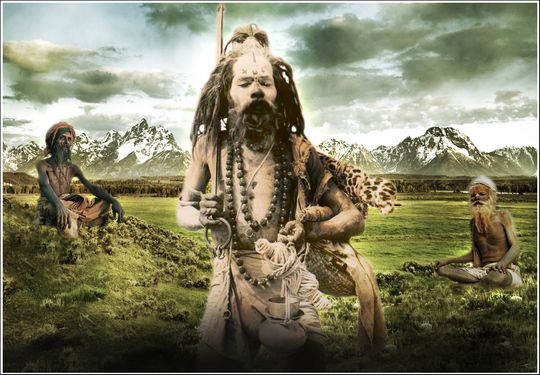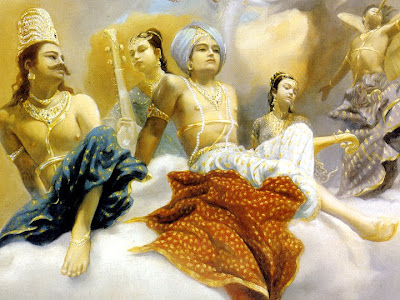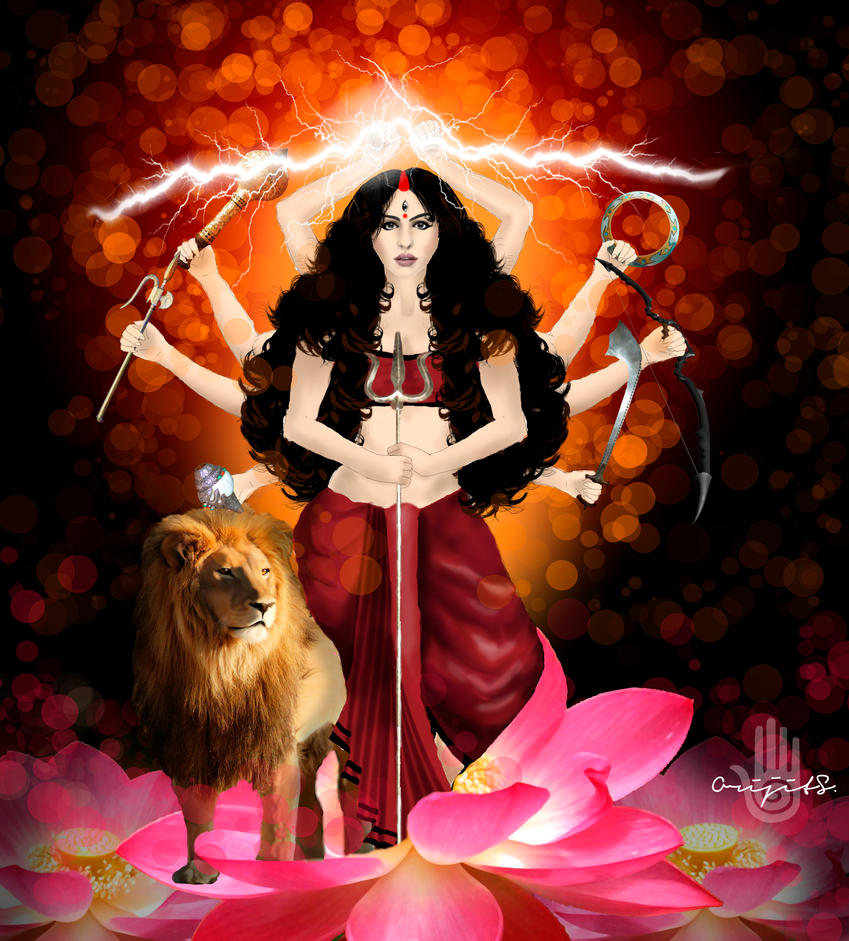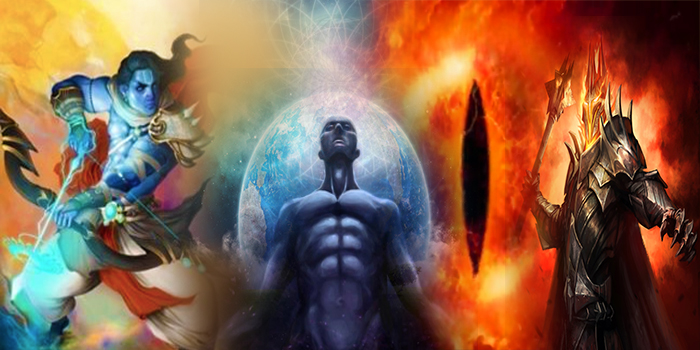 Hindus are inclined to accept anything that calls itself calls itself religion, particularly if it is also mystical. They would like to believe that all mystical states are valid and that all religions are true. This exposes them to manipulation by groups who use a religious or mystical appearance to promote their own agendas that may be anti-Hindu in nature. It is also contrary to their tradition.
Hindus are inclined to accept anything that calls itself calls itself religion, particularly if it is also mystical. They would like to believe that all mystical states are valid and that all religions are true. This exposes them to manipulation by groups who use a religious or mystical appearance to promote their own agendas that may be anti-Hindu in nature. It is also contrary to their tradition.
The Hindu Yoga tradition is well aware of the fact there are many different states of altered consciousness or mysticism. Not all of these are true, much less wholesome. There are various types of mysticism from what is little more than black magic to the highest Self-realization, and even experiences of Self-realization can be partial or mixed with lesser states. The Yoga tradition relates that even Asuras, beings of great pride and ambition, take to Yoga practices to gain greater powers to further their aim of world domination.
Religion, on one hand, has certainly been the greatest help for humanity in our eternal quest of Self- realization. Yet, on the other hand, it has also caused the greatest harm, inciting every sort of crime justified by the name of God. Religion can be not only the means of eradicating our human ego and its intractable biases, it can become the last and greatest attachment for the ego and the place in which our deepest prejudices can hide. Superstitions and hatreds can rest unquestioned in religion, particularly when they are attributed to God or his will.
 That individuals may have mystical experiences, therefore, does not necessarily indicate that they have gone beyond the limitations of the human ego. Major human faults can still exist in a person who can achieve genuine mystical states, if his development is not comprehensive or complete. Mystics can become greater religious fanatics than ordinary people if they take their experiences too personally.
That individuals may have mystical experiences, therefore, does not necessarily indicate that they have gone beyond the limitations of the human ego. Major human faults can still exist in a person who can achieve genuine mystical states, if his development is not comprehensive or complete. Mystics can become greater religious fanatics than ordinary people if they take their experiences too personally.
Some mystical states can exaggerate human emotions creating a superego, a being who has a greater awareness to manipulate others for his own ends. Such powerful egos can strongly impact society, as when the masses fall under the influence of a misguided charismatic mystic or religious leader. Such superegos themselves want to become God or his only representative, which affords them great power and authority. Their mystical experiences cause people to blindly follow them, which leads to aggression and destruction.
The spiritual realm therefore is not just a realm in which we can advance into divinity; it contains an antithetic possibility of drawing out subhuman or anti divine forces. Even a person who at times can speak the highest wisdom can fall into pride and anger, if he is not careful.
Even good mystics can be so blinded by their idealism and otherworldliness that others can manipulate them for worldly aims. Such a “naive saint” can be used as an image of holiness to justify religious aggression by the church or religious order. In addition, even if the attainments of a mystic are entirely wholesome, his teaching can be misunderstood and distorted by his followers.
This usually begins after the death of the mystic but sometimes its starts while he is still alive. Disciples of great teachers may not themselves be great and can become fanatics of another type, warring with one another for control of the teacher’s memory and the resources of his organization. They may use the image of the great teacher to further their own private ambitions or to promote their own personal prejudices. This is quite common when religions become institutions or gain government or military patronage. Misguided followers can turn a spiritual teaching aimed at self-development into a religious ideology aimed at world domination.
Devic and Asuric Mysticism
 Mysticism therefore can be divided into two basic types, what can be called the “light and dark,” or “pure and impure.” The first, I would call “Devic mysticism,” after the term Deva or Godly, which exists for purposes of union with the Divine or higher Self. It is based upon yogic principles of truthfulness, non-violence and tolerance and emphasizes yogic practices of self-control, asceticism and meditation.
Mysticism therefore can be divided into two basic types, what can be called the “light and dark,” or “pure and impure.” The first, I would call “Devic mysticism,” after the term Deva or Godly, which exists for purposes of union with the Divine or higher Self. It is based upon yogic principles of truthfulness, non-violence and tolerance and emphasizes yogic practices of self-control, asceticism and meditation.
It is an internal mysticism that has no external need to convert the world to a belief. Devic mysticism promotes Devic qualities of love, peace, selflessness and compassion.
The second could be called “Asuric mysticism,” after Asura for demon, titan or anti god, subtle beings of great pride, ambition and cunning. Asuric mysticism exists for promoting power or domination and projects a subtle but powerful ego.
It is mixed with non-yogic values and practices like intolerance, aggression, and violence. Asuric mysticism works through Asuric qualities of anger, hatred, pride and vengeance. Though it may employ internal practices it always has an external aim to convert, conquer or control the external world.
 Devic or divine mysticism is dominated by sattva guna, the quality of purity, light and goodness. Yet it should transcend even attachment to sattva, including attachment to religion. Asuric or power-seeking mysticism is dominated by rajoguna and always has a restless urge to assert and expand.
Devic or divine mysticism is dominated by sattva guna, the quality of purity, light and goodness. Yet it should transcend even attachment to sattva, including attachment to religion. Asuric or power-seeking mysticism is dominated by rajoguna and always has a restless urge to assert and expand.
Yet the boundary between these two types of mysticism is not always clear and the two types can be mixed together in a particular person or religious group. There are cases of mystics who have both very sublime experiences as well as exaggerated or monumental human failings. In addition at any stage a Yogi can fall into an Asuric state, pursuing power rather than realization, with his ego taking the spiritual realization as a sign of its own preeminence.
Even in non-dualistic paths, such delusions can occur with the mystic confusing the Divine Self or the Absolute with his own human personality, or Divine wisdom with his own intellectual achievements.
 In this regard Devic and Asuric elements can occur in all forms of mysticism and in all religions. Generally Devic mysticism requires more care, selflessness and training both to develop and to sustain. It is always easy to slip into Asuric states that are very appealing to the ego. For this reason untrained people who stumble into spiritual experiences are more likely to fall into Asuric delusions because they are unprepared to handle the expansion of awareness and energy that goes along with these states.
In this regard Devic and Asuric elements can occur in all forms of mysticism and in all religions. Generally Devic mysticism requires more care, selflessness and training both to develop and to sustain. It is always easy to slip into Asuric states that are very appealing to the ego. For this reason untrained people who stumble into spiritual experiences are more likely to fall into Asuric delusions because they are unprepared to handle the expansion of awareness and energy that goes along with these states.
But there can be organized forms of Asuric mysticism as well. Mystical groups employ various methods to achieve their aim, which are generally ascetic in nature. These include isolation, fasting, breathing exercises, prayers, mantras and meditation. Such methods can not only lead to higher states of consciousness, misdirected they can lead into delusion. They can be used not only for Devic ends but also for Asuric ends, producing a highly trained mind but for an egoistic agenda.
There are two basic characteristics of Asuric mysticism. The first is that it is colored by the ego. This leads the mystic to think that he has achieved some unique and special state that no one else has ever attained, that he is God’s chosen spokesman, if not God himself.
This can lead to further delusions that he must found a new religion or save the world – that he must speak for God and serve as an intermediary between others and God, who have no hope of salvation without him. He believes that truth is his sole possession and others must come to him to find God.
Such an inflation of one’s personal worth usually leads to a corresponding diminution of others, which is the second characteristic of Asuric mysticism. An Asuric mystic, with his claims for exclusivism, will be intolerant of other forms of spirituality. He looks upon those who do not accept his claims to holiness as a sign that they are fallen or evil. Just as he divinizes his own ego, he demonizes other spiritual groups as the enemy to be overcome.
 Generally this demonization proceeds according to superficial external characteristics. It usually condemns others according to their religious beliefs but can occur according to cultural or racial biases, marking some particular group as especially sinful and unholy. This creation of an enemy is an easy means of discrediting potential competition and setting up a final claim to truth. By creating an external scapegoat it further marshals the minds, hearts and resources of the faithful.
Generally this demonization proceeds according to superficial external characteristics. It usually condemns others according to their religious beliefs but can occur according to cultural or racial biases, marking some particular group as especially sinful and unholy. This creation of an enemy is an easy means of discrediting potential competition and setting up a final claim to truth. By creating an external scapegoat it further marshals the minds, hearts and resources of the faithful.
Asuric mysticism therefore polarizes the mind into self-glorification on one side and the denigration of others on the other. This is a volatile combination that easily erupts into violence and can infect the collective mind with powerful emotions of love and hate. The result of Asuric mysticism is that it ends up promoting conflict and war, both internally and externally. It is usually trapped in some duality of good and evil, the believers versus the non-believers.
When spiritual or yogic practices are used to promote a violent agenda, to willfully harm others, or to force them to adopt a belief, that mysticism becomes Asuric. This does not mean that it is necessarily ineffective. An Asuric or militant mysticism can use the cultivation of mystical states to provide a special occult or emotional energy to its efforts.
Asuric practices of hypnosis or mind control can be quite powerful in their results, getting people to do what they otherwise would have been incapable of. Asuric mysticism can be cultivated as readily as the Devic. It leads to non-yogic Samadhis, to delusionary states of altered consciousness in which the ego can gain superhuman powers. It creates a perverted idealism or self-righteousness that can grant great courage or will power, as well as the ability to incite the masses.
Militant Mysticism
 Not all mysticism is peaceful, as can be easily observed by the different forms of mysticism that have existed historically throughout the world. Many martial art traditions have existed employing mystical practices of breath control, prayer or meditation.
Not all mysticism is peaceful, as can be easily observed by the different forms of mysticism that have existed historically throughout the world. Many martial art traditions have existed employing mystical practices of breath control, prayer or meditation.
In most traditional societies warriors undergo a special training that aims at creating an altered state of consciousness, trying to make them impervious to pain and increase their physical strength and stamina.
There are many instances of armies using prayers, mantras, or magic spells as they go into battle, whipping themselves up into a frenzy to guarantee that they will fight better. Even today armies are led into battle with chants that God is great or victory to God. Militant and warrior mysticism has occurred all over the world. Not all of this has been for defensive purposes; some has been quite aggressive.
 Religious armies and religious wars dominated the Middle Ages and are still in effect with modern Jihads. In fact some religious urge or inspiration has led most armies. Most Asuric mysticism, with its emphasis on power and violence, develops from some sort of militant mysticism.
Religious armies and religious wars dominated the Middle Ages and are still in effect with modern Jihads. In fact some religious urge or inspiration has led most armies. Most Asuric mysticism, with its emphasis on power and violence, develops from some sort of militant mysticism.
Yet there are also priests or mystics who may not be warriors themselves but who encourage aggressive attitudes. They may work, either on a spiritual or intellectual level, to promote a militant agenda. These mystics may perform mantras, prayers or rituals to guarantee the victory of their faith, without themselves actually entering into battle.
However not all militant mysticism is objectionable. If it is done as a defensive measure there is nothing necessarily wrong with it.
If someone wrongfully attacks us we should call upon our God to help guide and defend us. It could be argued that Hindus, who have not fared well in defending themselves in recent centuries, would benefit by stressing a more militant or Kshatriya mysticism, such as is found in the Vedas or Mahabharata.
However if militant mysticism becomes a means of aggression, or of enforcing a religious belief, then it becomes Asuric in its nature. There are subtle negative forces, which delight in harm and destruction, that can be brought into the human realm. Asuric mysticism is therefore primarily a form of false Kshatriya mysticism. But it can be a distortion of priestly mysticism as well, if the priests are motivated by aggression.
Asuric Mysticism and Asuric Religions
The Asuras are represent those forces of nature which fight against the Divine will toward the evolution of consciousness in the universe and try to preserve prior material forms and conditions. They create division, conflict and destruction and strive to prevent human beings from advancing to a higher awareness. The Devas work to further the Divine will that tries to break through developed forms and limitations, promoting higher aspirations.
 The Devas and Asuras, the Gods and the Antigods and their energies, are ever at war for the souls of men and cultures. Generally more materialistic cultures with their efforts to control the external world naturally ally themselves with the Asuras, who represent an external view of reality. More spiritual cultures, with their internal vision and culture of contemplation, ally themselves with the Devas.
The Devas and Asuras, the Gods and the Antigods and their energies, are ever at war for the souls of men and cultures. Generally more materialistic cultures with their efforts to control the external world naturally ally themselves with the Asuras, who represent an external view of reality. More spiritual cultures, with their internal vision and culture of contemplation, ally themselves with the Devas.
Materialistic cults like communism, therefore, can easily develop destructive Asuric traits, as the history of communism with its state control, terrorism and genocide reveals. Materialistic capitalism is another belief system that can be used by Asuric forces, with the hypnosis of mass advertising and consumerism that trap people in the external world of desire. Yet, as these two systems indicate, the Asuras do have their idealism, communism with its utopian ideals or capitalism with its ideal of enjoyment for all.
The Asuras are the forces of matter and the underworld. They manipulate people through lower vital urges of power, sex, money and drugs. They can use commercial methods, like advertisement, which is a kind of mind control, or political propaganda to stir up passions and desires. However, they can take on a religious front in order to further their aims. They will even use occult forces or yogic methods once they have discovered their usefulness.
 They will stop short at nothing in the pursuit of power, which is their prime motivation. A number of religious groups, therefore, are influenced, if not dominated by Asuric tendencies. These are not simply strange cults of crime and perversion, which are but the most extreme such manifestations. They include religious beliefs that aim at political control, which are exclusive, intolerant, and aggressive.
They will stop short at nothing in the pursuit of power, which is their prime motivation. A number of religious groups, therefore, are influenced, if not dominated by Asuric tendencies. These are not simply strange cults of crime and perversion, which are but the most extreme such manifestations. They include religious beliefs that aim at political control, which are exclusive, intolerant, and aggressive.
Such groups are often successful for this very reason. They know no real higher values and so can employ the religious urge of people, which encourages great sacrifice, to further their outer aim of domination. They can project a religious fervor to the basic human urges for power, position and property.
Religious fundamentalism and militancy, the attempt to conquer the world for a belief, is a form of spiritual materialism, a reduction of the spiritual life to outer signs, names and slogans. It is vulnerable to Asuric forces, sometimes of the worst order, as the history of crusades, holy wars and inquisitions clearly reveals.
 In their efforts at conversion they tend to resort to propaganda, bribery and violence, which opens them up to Asuric qualities and energies. The very need to convert others is already a form of intolerance and sets in motion destructive forces in that the Asuras can benefit from. Opposed to these missionary religions are what could be called “Devic religions,” Dharmic traditions like Hinduism and Buddhism, that emphasize meditative paths of self-discovery apart from any dogma or need to convert anyone to a belief.
In their efforts at conversion they tend to resort to propaganda, bribery and violence, which opens them up to Asuric qualities and energies. The very need to convert others is already a form of intolerance and sets in motion destructive forces in that the Asuras can benefit from. Opposed to these missionary religions are what could be called “Devic religions,” Dharmic traditions like Hinduism and Buddhism, that emphasize meditative paths of self-discovery apart from any dogma or need to convert anyone to a belief.
In fact organized religion of any type tends to become Asuric. The creation of an institution to promote a belief and convert the world affords a natural place for Asuric drives for power and position to manifest. That is why Eastern religions like Hinduism, Buddhism, and Taoism have remained loosely organized outwardly, emphasizing inner experience on a personal and local level.
To reduce Asuric forces in humanity, therefore, religious institutionalism must be reduced in favor of individual religious freedom. The Asuras are usually better outwardly organized than the Devas, who have to win on an individual level. This makes the task of the Devas more arduous. Devic religions recognize the law of karma and rebirth. They regard each individual as unique, at a different stage of karmic development and requiring different practices.
For this reason they do not emphasize a mass teaching or the same belief for everyone. They remain flexible and do not seek to force people into any particular mold but, rather, seek to allow the true nature of each person to unfold from within. Predominant Western religious groups, with few exceptions, do not recognize the great truths of karma and rebirth. This makes them more likely to fall under Asuric influences, which are inflexible and project the same belief and practice for everyone.
They postulate some world or bodily condition as final, generally Heaven for their followers and Hell for their enemies, which turns anyone who thinks differently about God or truth into the enemy. They do not honor the individual soul in others but seek to convert all individuals to their belief, which is regarded as the absolute truth for everyone. Such missionary beliefs fail to see the value of the great mystical traditions of other religions and cast them in a negative light as well.
It is the nature of Asuric religious groups to attack Devic groups, just as the Asuras ever war with the Devas. They do this by demonizing Devic religions, by pretending that the Devas are the real demons.
This leads them to acts of intolerance like smashing idols, destroying temples, and killing priests under the guise that these are unholy. On the other hand, the Devas looks upon the Asuras as misguided energies and the people who follow them as misguided souls.
The Devas seek to redeem the Asuras if this is possible. The Devas do not demonize the Asuras, though they do recognize their destructive potential. Unfortunately, Devic groups are often naive in the ways of the world and may not develop the proper energy or insight to deal with the Asuras, who commonly use insincerity and deceit.
In fact, human nature as its stands today all over the world is dominated by Asuric or materialistic tendencies. We can easily observe this by human behavior in all spheres of life motivated by desire, greed and ambition, which are Asuric forces.
These Asuric tendencies come out in almost any circumstance or group, particularly when power is an issue, including in the religious sphere that can offer more power than any other domain of life. The Devas are usually in an inferior position in this human world that is dominated by Asuric tendencies. Even their supporters can fall prey to these if they are not careful. Hence what is formulated along Devic lines can in time become an Asuric force. Even a religion that has started out in a Devic form can be taken over by Asuric impulses. This occurs when spirituality and religion are used to gain worldly power and prestige and the inner quest is forgotten.
The Duality Between the Devas and Asuras
 Yet the duality between the Devas and Asuras is not absolute and should not be confused with any simplistic good and evil. The Asuras represent elemental energies and vital passions, the forces of rajas (rajoguna), which have their place in the cosmic order.
Yet the duality between the Devas and Asuras is not absolute and should not be confused with any simplistic good and evil. The Asuras represent elemental energies and vital passions, the forces of rajas (rajoguna), which have their place in the cosmic order.
However these powers of action must be subordinated to the higher laws of the Devas (the forces of mind and spirit) and sattva guna (peace and clarity) for them to function properly.
A Divine or sattvic type of action or rajas must become dominant, absorbing the active force into a higher aspiration, making the Asuras serve the Gods. The Asuras therefore cannot be destroyed but only controlled. To them belongs the underworld, the realm of elemental and vital forces, and the Gods strive to hold them there to do their work. The Asuras, however, in their pride strive to invade the Earth through the underworld and to gain control of humanity.
Because of their restless energy the Asuras can never rest content in their native domain but must ever strive upward until the Gods cast them back down again.The Asuras generally come to power when the Gods become weak. The Gods, being dominated by sattva guna, or peace and happiness, are inclined to become self-content or complacent. They can lose their energy or passion and get caught in the image of their own virtue.
 The Gods also can become too otherworldly in their views and shirk their responsibility to the creation, which affords a vacuum that the Asuras come in to fill. When the Gods hold to knowledge (vidya) alone and give up action (karma), this allows the Asuras to enter into the world.
The Gods also can become too otherworldly in their views and shirk their responsibility to the creation, which affords a vacuum that the Asuras come in to fill. When the Gods hold to knowledge (vidya) alone and give up action (karma), this allows the Asuras to enter into the world.
The Asuras are present in the cosmic order to keep both the Devas and humans vigilant and active in their higher evolution. Otherwise they may become content to stay at a particular level and cease to grow. For this reason various Gods and sages have at times protected the Asuras from being totally destroyed by the Gods, or even incited the Asuras to become more active.
Asuric religions similarly have great passion, but this passion is misplaced or misguided. It is a power of the emotional ego, tinged with exclusivism and intolerance. The Gods can only overcome the Asuras if they create a stronger energy or passion but of a divine or non-egoistic nature, which requires considerable effort or tapas. Only a Divine passion or sattvic rajas to overcome the undivine or tamasic rajas of the Asuras. The aggression of Asuric religions and the hypnotic appeal of Asuric mysticism can only be countered by a greater zeal by the Gods and Devic religions.
 The problem is that the Devic religions in humanity, mainly Hinduism and Buddhism, have become passive and resigned, lacking in passion and human interest. This makes the emotional human being vulnerable to Asuric influences. Devic religions in their otherworldliness fail to counter conversion efforts by Asuric groups and do not work hard enough to attract people into their ranks.
The problem is that the Devic religions in humanity, mainly Hinduism and Buddhism, have become passive and resigned, lacking in passion and human interest. This makes the emotional human being vulnerable to Asuric influences. Devic religions in their otherworldliness fail to counter conversion efforts by Asuric groups and do not work hard enough to attract people into their ranks.
Hence at this stage in humanity Asuric religious influences prevail, not only because of their inherent aggression but because of the present passivity of Devic Dharmas. It is important for Devic groups to look back to the older Vedic teaching that contains an integral Dharma of both knowledge and work (vidya and karma) through which the Divine force can remain supreme both in the outer and inner worlds.
Therefore, Devic forces should not simply label Asuric forces as negative. Nor should they passively blame the Asuras for the problems in the world as if they were no more than victims (hardly a Devic attitude we should note). Only when the Deva Shakti is weak can the Asura Shakti come forth. The Devas must arouse themselves to counter the influence of the Asuras. This requires not only that they become more active but that they seek a higher inspiration and zeal. They must unite with the Divine Lord and Protector, Vishnu, and seek a new avatara, or descent of Divine grace to lead them into the inevitable battle.
 An army of the Gods must be raised to counter the army of the Asuras. A new Indra (king of the Gods) must manifest to lead the Gods to a new victory over the Asuras. A Divine devotion and selfless force must emerge to counter the human devotion and blind faith of the Asuric nature. This is the real challenge to Dharmic traditions that they must now take up or perhaps perish. The Asuras in their passion can defeat the Gods who are lazy and complaisant.
An army of the Gods must be raised to counter the army of the Asuras. A new Indra (king of the Gods) must manifest to lead the Gods to a new victory over the Asuras. A Divine devotion and selfless force must emerge to counter the human devotion and blind faith of the Asuric nature. This is the real challenge to Dharmic traditions that they must now take up or perhaps perish. The Asuras in their passion can defeat the Gods who are lazy and complaisant.
A sincere Asuric passion is more compelling to the human heart than a weak or devitalized Divine vision. It is perhaps the loss of vital energy in the Hindu and Buddhist traditions that allowed them to be defeated and overcome by less evolved but more determined religious groups in the first place. Therefore the message of Deva and Asura is that one must not only beware of falling into an Asuric mode, but of becoming so passive in a higher Dharma that Asuric forces are encouraged to attack.
In this regard Hindus should blame their own weakness and lack of response for the perpetuation of Asuric beliefs in India. Had Hindus been united and strong in their own Dharma this would not have occurred. Similarly if Hindus not only unite but also regenerate a dynamic energy and warrior strength of Dharma, they can once more overcome these Asuric forces or even redeem them and bring them once more over to the side of the Gods.
Asuric Mysticism and India
 Asuric mysticism is well documented in Hindu tradition. Ravana, the great enemy of Lord Rama, was not only an Asura but came from a Brahmin background. Other great Asuras like Hiranyakashipu or Bali were defeated by Vishnu, while Prahlad, a noble Asura, became a great devotee of Vishnu.
Asuric mysticism is well documented in Hindu tradition. Ravana, the great enemy of Lord Rama, was not only an Asura but came from a Brahmin background. Other great Asuras like Hiranyakashipu or Bali were defeated by Vishnu, while Prahlad, a noble Asura, became a great devotee of Vishnu.
Asuric mysticism usually occurs when people of Kshatriya or warrior temperament (those who represent rajoguna in society) reject the rule of the Brahmins or those of spiritual knowledge, the true priests, monks and yogis, or when they come to follow false Brahmins, those who have no true spiritual knowledge or only that of a mixed or distorted type.
This split between the Brahmin and Kshatriya elements in humanity can also occur when the Brahmins (forces of knowledge) reject or fail to properly acknowledge the importance of the Kshatriya (force of action) and abandon the Kshatriyas, failing to guide and support them, which causes them to turn against the Brahmins. Such fallen Kshatriyas set themselves up as the highest spiritual law of the land and refuse to honor those who have renounced the world for higher values.
Asuric mysticism therefore is Kshatra without Brahmin and its heroes are usually generals and warriors, aggressive soldiers who may be called martyrs if they fall in battle. True Kshatriya mysticism, which contains various forms of martial arts, is Brahma with Kshatra. Its heroes are warriors who fight to create peace in the world so that the spiritual practices of the sages are not interfered with.
This is the example of Rama in the Ramayana and the Pandavas, particularly Arjuna, in the Mahabharata. In true Kshatriya mysticism force is never used to impose a religious belief upon others. The problem of India today consists of Brahmin without Kshatra, spiritual knowledge without any power or method to rule society. Many spiritual people have shirked their social responsibility and abandoned the social field to worldly forces.
 Naturally this reinforces Kshatra without Brahmin, people who use militant methods or corruption to gain their ends, even taking a religious form for this purpose. Hindus need a Brahmin that creates Kshatra and a Kshatra that follows Brahmin, the correct balance of spiritual knowledge and a righteous social order. This is Sanatana Dharma and the ancient way of Bharatiya society.
Naturally this reinforces Kshatra without Brahmin, people who use militant methods or corruption to gain their ends, even taking a religious form for this purpose. Hindus need a Brahmin that creates Kshatra and a Kshatra that follows Brahmin, the correct balance of spiritual knowledge and a righteous social order. This is Sanatana Dharma and the ancient way of Bharatiya society.
Hindus must awaken and reject Asuric beliefs and values, whether in their own society or coming from other religious groups. For Hindus to accept Asuric religious beliefs or practices as true and valid, whether in their tradition or outside of it, is to deny the Dharma. For Hindus to excuse the Asuric actions of others, like tolerating the violence and exclusivism of Western religions, is simply naive. Hindus must learn to throw off this Asuric or false Kshatriya energy for one that is wholesome and sattvic. Hindus therefore need a new spiritual Kshatriya to overcome these Asuric forces.
All over the world the Asuric force is predominant. We live in an age of power, propaganda, and commercialism, which all have an Asuric appeal. To counter this the Devic force must arouse itself and take humanity in a new direction. If Devic traditions cannot arise and challenge this Asuric dominance, then its negative energy and destructive consequences are bound to increase.
The importance of India is that it is a country where the Deva Shakti has been the most active historically. India itself is the land of Durga, the Divine Mother who herself is the manifestation of the Deva Shakti, and who has the real power to conquer the Asuras. If this Shakti cannot awaken again in India, it does not bode well for the rest of humanity either.
May that Durga force arise again!
–































